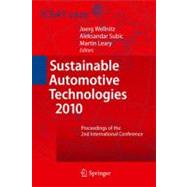
| Technologies and infrastructure for sustainable mobility | p. 1 |
| Towards a sustainable vehicle development | p. 3 |
| EADS commitment towards sustainable mobility | p. 9 |
| Build-up strategies for a hydrogen supply and refuelling infrastructure including a comparative outlook on battery-electric vehicles and their infrastructure requirements | p. 17 |
| Approach for the solution of a simplified Reissner theory for automotive application | p. 29 |
| Greener roads by talking traffic lights: knowledge about queue length and upcoming traffic light signal | p. 37 |
| Sustainable antennas - a wideband antenna for vehicular applications | p. 45 |
| Solution for reduced pollution and congestion | p. 51 |
| Emission versus E-mission - ways to a sustainable powertrain | p. 53 |
| Sustainable vehicle design and manufacture | p. 61 |
| Benchmarking and optimisation of automotive seat structures | p. 63 |
| Vision-aided position control method for manufacturing machines | p. 71 |
| Automated fibre placement with in situ ultra-violet (UV) light curing: concept testing | p. 79 |
| Multifunctional vehicle components: key in sustainability and long term viability of auto industry | p. 87 |
| Knowledge management in cross-company research and development projects | p. 93 |
| New vehicle concepts | p. 101 |
| Structural optimization processes for finding robust automotive lightweight concepts | p. 103 |
| Transitioning to the future of hydrogen mobility | p. 109 |
| Green car technologies roadmap - challenges and opportunities | p. 115 |
| A new hybrid material for increased impact tolerance | p. 123 |
| The importance of hydrogen as secondary energy carrier for renewable primary energies | p. 131 |
| Efficiency improvement of internal combustion engines by waste heat recovery with Rankine cycle and an advanced turbocharging principle | p. 141 |
| New structures and materials | p. 151 |
| Cellular titanium a bionic material for automotive and avionic applications | p. 153 |
| Research and development of a new and sustainable composite: natural stone laminate | p. 159 |
| Delamination of composite structures and failure modes of bonded elements | p. 167 |
| Application of supersonic flame spraying for next generation cylinder liner coatings | p. 175 |
| Enhanced shape momory alloy actuators | p. 183 |
| Damage behavior of bonded structures under static and cyclic loading conditions | p. 191 |
| Advanced manufacturing for fiber reinforced metal matrix composites (MMC) | p. 199 |
| Opportunities and limits for composites in cars | p. 207 |
| New power train technologies | p. 215 |
| Formula hydrogen - international dimensions of the hydrogen powered racing car project | p. 217 |
| Analysis of potential increases in energy efficiency for piston combustion machines with unconventional geometry | p. 223 |
| Formula H - design and development of a student-built hydrogen fuelled racing car | p. 233 |
| Formula H - risk assessment and safety strategies in a student hydrogen vehicle project | p. 241 |
| End-of-life vehicle management | p. 249 |
| Increase of recuperation in vehicles with conventional powertrain | p. 251 |
| Hybrid concept for energy redistribution within transportation systems | p. 261 |
| A system dynamics approach to calculating the energy consumed in car component production | p. 271 |
| Vehicle and public safety | p. 279 |
| Vehicle and public safety through driver assistance applications | p. 281 |
| Author Index | p. 289 |
| Table of Contents provided by Ingram. All Rights Reserved. |
The New copy of this book will include any supplemental materials advertised. Please check the title of the book to determine if it should include any access cards, study guides, lab manuals, CDs, etc.
The Used, Rental and eBook copies of this book are not guaranteed to include any supplemental materials. Typically, only the book itself is included. This is true even if the title states it includes any access cards, study guides, lab manuals, CDs, etc.